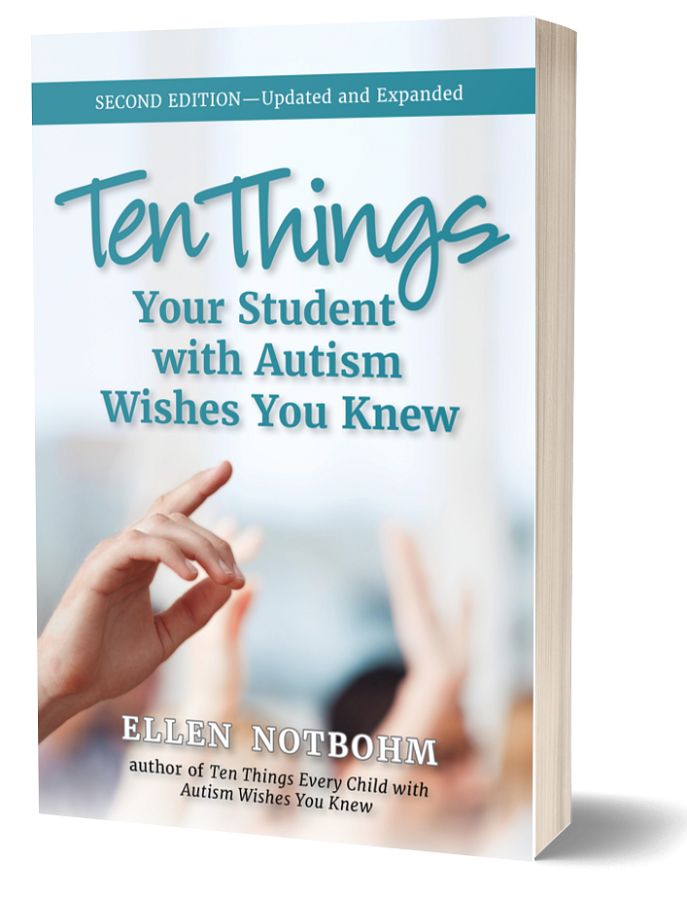Excerpt
Ten Things Your Student With Autism Wishes You Knew, 2nd edition (2022)
from Chapter 9
Believe
I began writing this chapter as an exploration of what it means to believe in a child, to instill and nurture an attitude of confident can-do in a student, and in ourselves as teacher-adults. It’s still about that, but the autistic adult community has spoken out more loudly in recent years, a message that society’s general failure to believe them when they relate their experiences about being autistic is a major obstacle to their being able to fully integrate with community as their authentic, capable, valuable, and productive selves.
Long before an autistic child understands what you mean by “I believe in you,” they will understand and need to hear, “I believe you.”
One of the most poignant stories ever told in one of my round table groups came from a grandmother whose grandson had been sent home from school for “behavior” and refused to talk to his mother or anyone but Grandma. Why? Because, he told her, “No one wistens to me. No one bewieves me.” He’d tried to communicate that he’d been bullied. When no one stepped up to help, he retaliated in kind. He, not the abuser, had been punished for his behavior. His grandmother called that day A Lesson in Listen for all concerned.
So many autistic children and adults say that one of the most difficult aspects of their autism is that “no one bewieves” them. Whether it’s sensory issues, social situations, or motor or cognitive challenges, too often the response is denial.
It’s yucky.
No, it’s not; it’s good for you.
I don’t get it. I don’t know how to do this.
Try harder.
I don’t understand what you’re saying.
Look me in the eye and listen up!
It’s too bright/too loud/too creepy/too cold.
No, it’s not, so buck up (suck it up, straighten up, chin up).
As the child in the story above so deftly illustrated, believing that our perspective is the only believable one is a surefire way to ensure that meaningful communication, problem solving, and learning won’t happen.
If you’ve ever started a sentence with, “Believe me . . .” (and who among us hasn’t?), it shouldn’t be hard to put yourself in the shoes of a child who wants to be believed but can’t take for granted, as many of us do, that she will be. “Never underestimate the power and influence of validating a child,” wrote one of my Facebook readers who grew up to be an educator. “I went to three different schools in first grade because I had a mother who believed me and fought to find the right environment for me.”
But another reader expressed reluctance about wholesale believing autistic children because they don’t always communicate “authentically.” True that may be sometimes, but learning to communicate authentically (a subjective word) is a lifelong process of constant refinement, autistic or not. We have to start by instilling in the child that we will listen respectfully to whatever manner in which they wish to communicate, and then proceed from there. If a child told me he rode a unicorn to school, I would never say, “No, you didn’t. Unicorns aren’t real.” I would say, “Wow, I’ve never seen a unicorn. I’m curious—tell me more!” Then I would listen and follow up with the exploratory questions that would help me understand what he’s trying to communicate and why in this manner. Indirect communication doesn’t necessarily equate to inauthenticity.
The scars of not believing our children can last a lifetime. From a distance of many decades, Jennifer McIlwee Myers relates her early elementary school experience:
“The weird (and incredibly frustrating) thing to me was that teachers would refuse to believe me when I really had no reason to lie and wasn’t doing anything wrong. In second grade health class, we were taught that we needed to swallow our food before taking a drink to avoid choking (????). I told the teacher privately that I couldn’t do it. I just could not successfully swallow food without taking a slug of liquid to wash it down.
“Her response? ‘Oh, I think you can. I think you need to try a little harder.’
“I still can’t eat without using a beverage to wash down every bite. Never could. And I could never convince that teacher that I wasn’t lying to her or being lazy. She was the most popular teacher in the school, both with students and teachers. All her students, including me, adored her. But she couldn’t accept oral-motor differences as a possibility. Nor would she believe sensory issues were real.
“That was the year I learned that there was literally no adult I could trust or lean on. Over and over I found that every single one believed they knew what I thought, felt, and experienced better than I did and simply dismissed anything I said to the contrary. Being autistic meant living in a world of constant de facto gaslighting.”
*****
Buy Ten Things Your Student With Autism Wishes You Knew, 2nd edition (2022)

